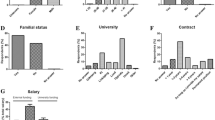Abstract
Do the best Italian academics move abroad? What is the academic productivity of an Italian researcher working in Italy compared with one working abroad? Does academic productivity depend on their well-being at work? The aim of this study is to find explanations for these questions and to demonstrate the relationship that exists between academic productivity and organizational well-being and work, both for researchers who are Italian emigrants abroad (project IRA) and for those who remain in Italy (IRI project).This goal was achieved through two surveys. Where there is an atmosphere of a wellness organization, it creates a productive work environment (vision abroad); conversely, a poor working environment that is associated with an organizational system that is below the average level negatively affects the overall academic productivity (in Italy). We can confirm that working environments with better organizational climate produce more productive academics.
Similar content being viewed by others
Notes
In Italy there are a number of databases with the number of graduates who emigrate that are suitable for the purposes of micro-data analysis. Though trends can be identified, it is not possible to provide an in-depth analysis of attitudes and propensity. Using databases with micro-data makes it possible to gain an insight into the opinions of individuals.
The Likert scale measures attitudes. This technique is particularly useful as it allows for the application of methods of item analysis based on the statistical properties of interval- or ratio-based scales. The Likert method is faster and simpler than the Thurstone method, and it has been used extensively in applied research.
The Kendall τ b rank correlation coefficient [or simply the Kendall tau coefficient, Kendall's τ or tau test(s)] is a non-parametric statistic (Kendall 1938. pp.81–89).
References
Abramo, G., D’angelo, C. A., & Caprasecca, A. (2008). Allocative efficiency in public research funding: Can bibliometrics help? Research Policy, 38(1), 206–215.
Beccari A., -Torrisi B. (2003). New statistical methodology for variable selection: a chemiometric application. Italian Journal of Applied Statistics, 15(3)
Biondo, A. E., Monteleone, S., Skonieczny, G., & Torrisi, B. (2012). Propensity to return: Theory and evidence of Italian brain drain. Economics Letters, 115, 359–362.
Bonaccorsi, A., Darario, C., & Simar, L. (2006). Advanced indicators of productivity of universities. An application of robust nonparametric method to Italian data. Scientometrics, 66(2), 389–410.
Bozeman, B., & Corley, E. (2004). Scientists’ collaboration strategies: Implications for scientific and technical human capital. Research Policy, 33, 599–616.
Corley, E. A. (2005). How do career strategies, gender, and work environment affect faculty productivity levels in university-based science centers? Review of Policy Research, 22, 637–655.
Corley, E. A., & Sabharwal, M. (2007). Foreign-born academic and engineers: Producing more and getting less than their U.S. born peers? Research in Higher Education, 48(8), 909–940.
Fox, M. F., & Mohapatra, S. (2007). Social-organizational characteristics of work and publication productivity among academic scientists in doctoral-granting departments. The Journal of Higher Education, 78(5), 542–571.
Gilli G. (2010). Produttività scientifica globale e di Eccellenza delle Università Statali Italiane nel periodo 1975–2010. Working paper Dipartimento di Chimica dell’Università di Ferrara. Ferrara.
Gulbrandsen, M., & Smeby, J. C. (2005). Industry funding and university professors’ research performance. Research Policy, 34, 932–950.
Hermanowicz, J. C. (2003). Scientists and satisfaction. Social Studies of Science, 33(1), 45–73.
Kendall M. G. (1938). A new measure of rank correlation. Biometrika, 30, 81–93
Markusova, V. A., Tsygankova, A. I., & Krylova, T. A. (2009). The indices of scientific productivity and ratings of domestic universities. Scientific and Technical Information Processing, 36(4), 229–233.
Monteleone S., & Torrisi B. (2012). Italian researchers abroad: A multivariate analysis of migration trends. Rivista Italiana degli Economisti XVII(1).
Monteleone S., & Torrisi B. (2012). Geographical analysis of the academic brain drain in Italy. Scientometrics (in press).
Salaran, M. (2010). Research productivity and social capital in Australian higher education. Higher Education Quarterly Volume, 64(2), 133–148.
Sax, L. J., Hagedorn, L. S., Arredondo, M., & Dicrisi, F. A. (2002). Faculty research productivity: Exploring the role of gender and family-related factors. Research in Higher Education, 43(4), 423–446.
Skonieczny G., & Torrisi B. (2009). A statistical approach to study the determinants geographic mobility of brain drain. In Proceedings of Second Arab Statistical Conference, Surt. Surt.
Skonieczny G., & Torrisi B. (2011). Fuga del capitale umano italiano di alta qualificazione: esclusione sociale o povertà indotta?”. Rivista Italiana di Economia Demografia e Statistica. 3/4.
Stack, S. (2004). Gender, children and research productivity. Research in Higher Education, 45(8), 891–920.
Torrisi B. (2012). La produttività accademica correlata al benessere lavorativo dei ricercatori italiani in Italia e all’estero. Rivista Italiana di Economia Demografia e Statistica (in press).
Tower, G. (2006). A multidisciplinary study of gender-based research productivity in the world’s best journals. Journal of Diversity Management, 2(4), 23–32.
Van Raan, A. F. J. (2005). Challenges in ranking of universities. First International Conference on World Class Universities, Shanghai. Shanghai: Shanghai Jaio Tong University.
Author information
Authors and Affiliations
Corresponding author
Electronic supplementary material
Below is the link to the electronic supplementary material.
Rights and permissions
About this article
Cite this article
Torrisi, B. Academic productivity correlated with well-being at work. Scientometrics 94, 801–815 (2013). https://doi.org/10.1007/s11192-012-0709-6
Received:
Published:
Issue Date:
DOI: https://doi.org/10.1007/s11192-012-0709-6




